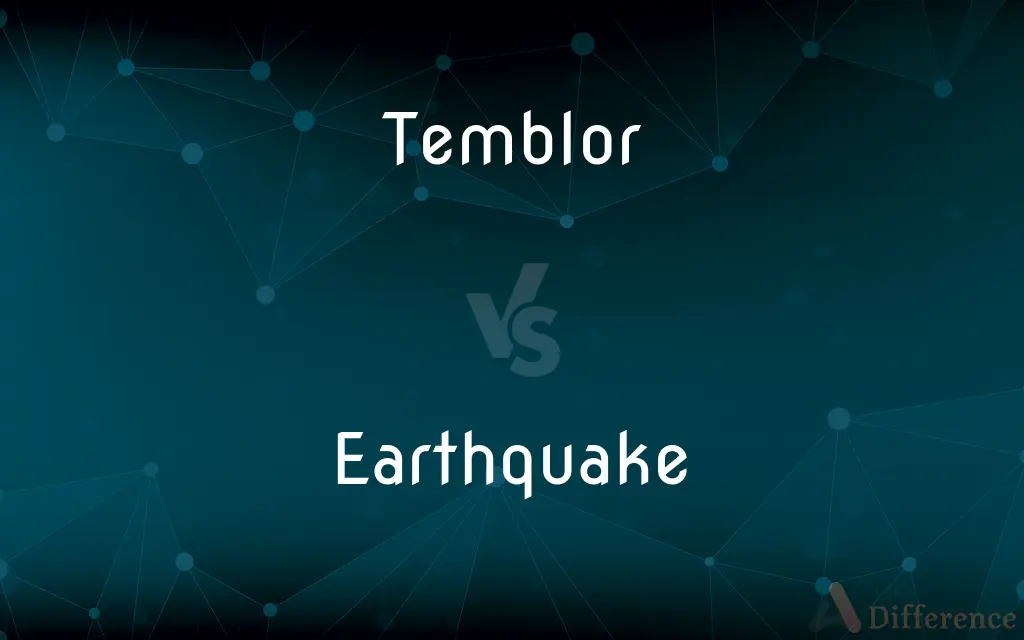Temblor vs. Earthquake — What's the Difference?
Edited by Tayyaba Rehman — By Urooj Arif — Updated on April 8, 2024
Temblor refers to the shaking caused by underground movement, while an earthquake describes the geological event causing such shaking.

Difference Between Temblor and Earthquake
Table of Contents
ADVERTISEMENT
Key Differences
Temblor and earthquake both describe seismic activities but from slightly different perspectives. A temblor focuses on the sensation or act of shaking itself, originating from underground movements, usually along faults within the Earth's crust. This term is often used in casual or informal contexts. On the other hand, an earthquake encompasses not only the shaking but also the geological event responsible for this activity, including the release of energy along fault lines or from volcanic activity, which can be measured and analyzed scientifically.
While temblors are essentially the experience or manifestation of earthquakes, the term "earthquake" is used in more technical or scientific discussions. It implies a broader scope, including the study of seismic waves, the measurement of magnitude and intensity, and the analysis of earthquake impacts on structures and environments.
The terminology often reflects the audience or context. For instance, news reports might use "temblor" to convey the human experience of feeling the ground shake, whereas scientific reports prefer "earthquake" to discuss the event's specifics, including its cause, measurements, and implications.
The distinction also lies in the detail and depth of information provided. "Earthquake" may accompany discussions on preventive measures, seismic risk assessments, and engineering adaptations, reflecting a comprehensive approach to understanding and mitigating earthquake-related hazards.
While both terms are used interchangeably by the general public, the precision in terminology becomes crucial in academic, scientific, and emergency management contexts, where understanding the nuances can aid in more effective communication, research, and disaster response strategies.
ADVERTISEMENT
Comparison Chart
Definition
The shaking caused by underground movements.
A geological event causing the ground to shake.
Context
Informal, focusing on the experience of shaking.
Technical, encompassing both the event and its study.
Scope
Limited to the sensation or act of shaking.
Includes cause, measurement, and effects of shaking.
Usage
More common in casual discussions and reports.
Preferred in scientific, technical, and research contexts.
Implications
Focuses on the immediate human experience.
Involves analysis, prevention, and mitigation strategies.
Compare with Definitions
Temblor
A sudden feeling of shaking from underground movements.
The temblor startled the residents, causing them to evacuate.
Earthquake
A focus of scientific and emergency preparedness.
The recent earthquake has led to an update in building codes.
Temblor
A localized shaking event.
The temblor was felt by all in the vicinity but did no major damage.
Earthquake
A geological phenomenon caused by the sudden release of energy.
Scientists study earthquakes to understand Earth's interior.
Temblor
An informal term for seismic activity.
The news mentioned a temblor in the area yesterday.
Earthquake
The cause of seismic waves.
The earthquake was felt across the region, prompting evacuations.
Temblor
A non-technical description of earth shaking.
After the temblor, everyone checked their homes for damage.
Earthquake
A seismic event characterized by ground shaking.
The earthquake's magnitude was measured at 6.3 on the Richter scale.
Temblor
The physical sensation of earth shaking without detailing cause.
People reported feeling a strong temblor last night.
Earthquake
An event measured by its intensity and magnitude.
The earthquake caused significant damage due to its high magnitude.
Temblor
See earthquake.
Earthquake
An earthquake (also known as a quake, tremor or temblor) is the shaking of the surface of the Earth resulting from a sudden release of energy in the Earth's lithosphere that creates seismic waves. Earthquakes can range in size from those that are so weak that they cannot be felt to those violent enough to propel objects and people into the air, and wreak destruction across entire cities.
Temblor
An earthquake.
Earthquake
A sudden movement of the earth's crust caused by the release of stress accumulated along geologic faults or by volcanic activity. Also called seism, temblor.
Temblor
An earthquake.
Earthquake
A shaking of the ground, caused by volcanic activity or movement around geologic faults.
Temblor
Shaking and vibration at the surface of the earth resulting from underground movement along a fault plane of from volcanic activity
Earthquake
(planetary geology) Such a quake specifically occurring on the planet Earth, as opposed to other celestial bodies.
Earthquake
(figuratively) A sudden and intense upheaval; a severely disruptive event.
Earthquake
(intransitive) To undergo an earthquake.
Earthquake
A shaking, trembling, or concussion of the earth, due to subterranean causes, often accompanied by a rumbling noise. The wave of shock sometimes traverses half a hemisphere, destroying cities and many thousand lives; - called also earthdin, earthquave, and earthshock.
Earthquake
Like, or characteristic of, an earthquake; loud; startling.
The earthquake voice of victory.
Earthquake
Shaking and vibration at the surface of the earth resulting from underground movement along a fault plane of from volcanic activity
Earthquake
A disturbance that is extremely disruptive;
Selling the company caused an earthquake among the employees
Common Curiosities
What is a temblor?
A temblor is the shaking felt from movements beneath the Earth's surface, often caused by an earthquake.
What causes an earthquake?
Earthquakes are caused by the sudden release of energy in the Earth's crust that creates seismic waves.
What should you do during a temblor?
During a temblor, it's advised to drop, cover, and hold on until the shaking stops to protect yourself from falling debris.
How are earthquakes measured?
Earthquakes are measured by their magnitude on the Richter scale and their intensity on the Modified Mercalli Intensity scale.
Are temblors dangerous?
Temblors can be dangerous if they are strong enough to cause damage to structures or trigger landslides and tsunamis.
How do temblors relate to earthquakes?
Temblors are the observable shaking or sensation experienced during an earthquake.
Can animals sense temblors before they happen?
Some animals are believed to sense the early warning signs of an earthquake, exhibiting unusual behavior before a temblor occurs.
How do temblors affect buildings?
Temblors can cause buildings to shake, leading to structural damage or collapse if not designed to withstand seismic forces.
Can a temblor occur without an earthquake?
No, a temblor is a direct result of seismic activity, such as an earthquake.
What is the difference between temblor and tremor?
A temblor specifically refers to shaking from an earthquake, whereas a tremor can refer to any slight shaking or trembling, including non-seismic causes.
What is the most earthquake-prone area in the world?
The Pacific Ring of Fire is the most earthquake-prone area, experiencing the majority of the world's earthquakes.
Why is the term "temblor" used?
"Temblor" is used in informal contexts to describe the sensation of shaking felt during an earthquake.
Can temblors be predicted?
Currently, scientists cannot predict the exact time and location of temblors, but research is ongoing to improve early warning systems.
What role do fault lines play in earthquakes?
Fault lines are breaks in the Earth's crust where earthquakes are more likely to occur due to the movement of tectonic plates.
How can we prepare for an earthquake?
Preparation includes securing heavy furniture, having emergency supplies on hand, and practicing earthquake drills.
Share Your Discovery

Previous Comparison
Later vs. After
Next Comparison
Cuddle vs. SpoonAuthor Spotlight
Written by
Urooj ArifUrooj is a skilled content writer at Ask Difference, known for her exceptional ability to simplify complex topics into engaging and informative content. With a passion for research and a flair for clear, concise writing, she consistently delivers articles that resonate with our diverse audience.
Edited by
Tayyaba RehmanTayyaba Rehman is a distinguished writer, currently serving as a primary contributor to askdifference.com. As a researcher in semantics and etymology, Tayyaba's passion for the complexity of languages and their distinctions has found a perfect home on the platform. Tayyaba delves into the intricacies of language, distinguishing between commonly confused words and phrases, thereby providing clarity for readers worldwide.
















































